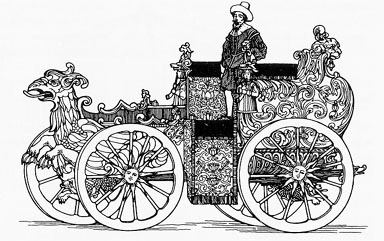 In those days, there was still a long way to go to the car., there was no engine. Therefore, the efforts of the constructors went only in the direction of independence or from the draft animal., or from people walking outside the vehicle and building a "self-driving"” also driven by humans or horses, but on the vehicle, or building a vehicle driven by mechanical energy.
In those days, there was still a long way to go to the car., there was no engine. Therefore, the efforts of the constructors went only in the direction of independence or from the draft animal., or from people walking outside the vehicle and building a "self-driving"” also driven by humans or horses, but on the vehicle, or building a vehicle driven by mechanical energy.
An example of such an inventor-constructor can be Johann Hautsch from Nuremberg, blacksmith and watchmaker, which he built in a year 1649 a large vehicle in the shape of a "terrifying dragon"”; we read about him: "(…) welcher ałso frey geht und bedarff keiner vorspannung weder von Pferden oder anders und gehtsolcher Wagen in einer Stund 2000 Schritt. Man kari stil halten, wann man wil, man kan fortfahren, wann man wil, und ist doch alles von Uhrwerck ge-macht”, which means: "which therefore goes freely and does not require a sled or horses or any other, and such a cart goes in an hour 2000 Steps. It can be stopped, when you want, you can drive it, when you want, and everything is made of a clockwork”.
In the light of other descriptions of the wagon, the above message from the "Nuremberg Chronicle"” doesn't seem quite true, rather, it was intended to advertise Hautsch's watchmaking skills.. In fact, it was suspected not without reason, that the car was moving (and he was actually moving) not because of the clockwork, but it was simply driven by two bollards hidden inside the "Dragon"”, cranks, connected by means of transmission to the rear and wheels of the vehicle. This was evidenced by the negligible speed of the car, not exceeding 1,6 kilometer per hour and only on a level road, and – the need to stop for a longer "rest"” after everyone's departure 100 Metres.
What Hautsch's vehicle looked like? it was a real "triumphal wagon"”, unusual richly gilded, decorated with sculptures and allegorical figures. On both sides of the vehicle, figures of angels raised small trumpets, making loud sounds, warning pedestrians of approaching car. A terrifying dragon's head protruded on the front. When the vehicle encountered thighs not leaving the road, the dragon rolled his eyes terribly, he opened his mouth and offered pedestrians a stream of water. Hautsch was therefore the inventor of the first automobile warning signal., similar to today's sirens and multi-ton signals, and the inventor of the method of dispersing confluences using fire brigade water cannons.
The press widely described the uniqueness of Hautsch's vehicle, opening the parade of carriages in Nuremberg. Therefore, soon the buyer came forward for this widely advertised miracle of technology., or, as some have insisted stubbornly, the product of Luciper himself. The vehicle was purchased for 500 thalers by the heir to the Swedish throne, Prince Charles Gustav, who used this car during the coronation ceremony in Stockholm. The King of Denmark also ordered a similar vehicle from Hautsch., which he even reportedly deigned to drive during the floral corsa of carriages arousing the enthusiasm of his subjects. The Chronicles give, that a similar car, powered by two people pedaling inside, was built in 1760 year. However, it was a combat vehicle, constructed by military engineers in Augsburg, therefore, instead of the head of the dragon, there was a cannon on the front of the vehicle.